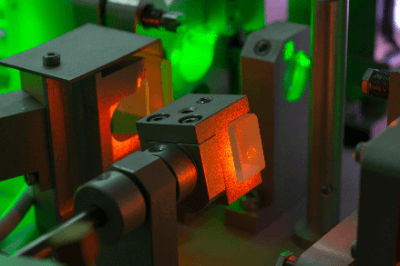What Is a Laser Oscillator?

A laser oscillator is a system that emits laser light.
A laser oscillator produces coherent light with excellent directional and monochromatic properties. The oscillator consists of a medium, an excitation source, and a resonance mirror, combined into a resonator.
Depending on the medium used, there are various types of lasers: gas, solid-state, liquid, semiconductor, and fiber lasers. Their light emission methods include CW (continuous wave) oscillation, pulsed oscillation, and Q-SW (Q-switched) pulsed oscillation.
Applications of Laser Oscillators
Laser oscillators are integral to devices utilizing lasers. Their applications span from military to consumer products, including home appliances.
Lasers are selected based on output, wavelength, and other characteristics for the intended purpose. Common applications include:
- Medical treatment
LASIK, retinal detachment treatment in ophthalmology, removal of spots and birthmarks in dermatology, etc. - Electrical appliances
Laser pointers, barcode scanners, optical drives for CDs and DVDs, etc. - Industrial equipment
Laser processing machines for drilling, cutting, engraving, welding, etc.
In scientific fields, lasers assist in lightwave rangefinding, non-destructive testing, LIDAR, and laser fusion among other applications.
Principles of Laser Oscillators
1. Excited States and Transitions
When an excitation source irradiates a medium, atoms or molecules in the laser medium transition from a low to a high energy state – the excited state. This state is unstable and quickly reverts to the low energy state, a process called a transition.
During this transition, light corresponding to the energy difference is emitted, known as spontaneous radiation. Induced emission occurs when an excited atom or molecule is irradiated with specific wavelength light, emitting light proportional to the light’s intensity.
2. Light Enhancement
The emitted light, reflected by the resonance mirror and returned to the laser medium, induces more light, enhancing it further. This repeated back-and-forth process eventually emits laser light from the semi-transmissive mirror at a certain intensity.
Structure of Laser Oscillator
The laser oscillator comprises an excitation source (like a lamp or laser semiconductor) and a resonator, which intensifies the light. The resonator includes a laser medium (a solid, gas, or crystal) and resonance mirrors.
The internal structure is arranged so the excitation source irradiates the laser medium, with resonance mirrors positioned on both sides of the medium. One mirror is partially transmissive, and the other is fully reflective.
Other Information on Laser Oscillators
1. CW Oscillation
CW (continuous wave) oscillation emits a continuous wave laser. Its output is constant over time, ideal for applications like airtight welding, where continuous melting prevents gaps.
2. Pulsed Oscillation
Pulse oscillation varies the laser output over time. In welding, it creates intermittent beads, reducing thermal deformation by limiting overall heat input.
3. Q-SW Pulse Oscillation
Q-SW pulse oscillation generates high power by waiting for sufficient inversion distribution in the laser medium before oscillating. It’s used in micro-processing and precision part drilling in electronics and semiconductors.